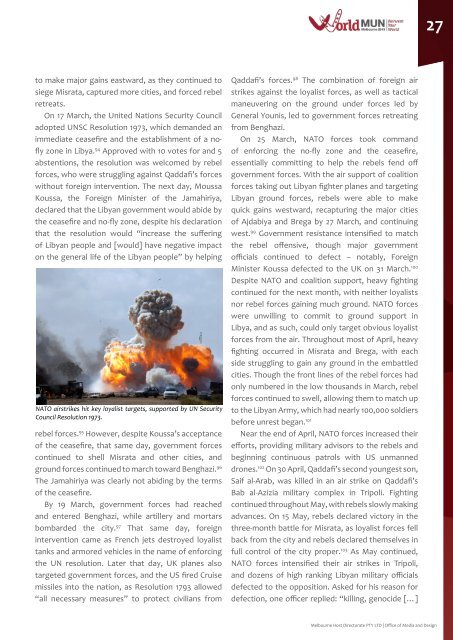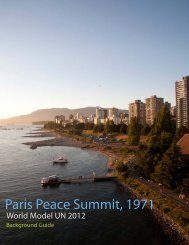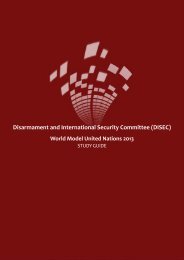National Transitional Council of Libya - World Model United Nations
National Transitional Council of Libya - World Model United Nations
National Transitional Council of Libya - World Model United Nations
Create successful ePaper yourself
Turn your PDF publications into a flip-book with our unique Google optimized e-Paper software.
to make major gains eastward, as they continued to<br />
siege Misrata, captured more cities, and forced rebel<br />
retreats.<br />
On 17 March, the <strong>United</strong> <strong>Nations</strong> Security <strong>Council</strong><br />
adopted UNSC Resolution 1973, which demanded an<br />
immediate ceasefire and the establishment <strong>of</strong> a n<strong>of</strong>ly<br />
zone in <strong>Libya</strong>. 94 Approved with 10 votes for and 5<br />
abstentions, the resolution was welcomed by rebel<br />
forces, who were struggling against Qaddafi’s forces<br />
without foreign intervention. The next day, Moussa<br />
Koussa, the Foreign Minister <strong>of</strong> the Jamahiriya,<br />
declared that the <strong>Libya</strong>n government would abide by<br />
the ceasefire and no-fly zone, despite his declaration<br />
that the resolution would “increase the suffering<br />
<strong>of</strong> <strong>Libya</strong>n people and [would] have negative impact<br />
on the general life <strong>of</strong> the <strong>Libya</strong>n people” by helping<br />
NATO airstrikes hit key loyalist targets, supported by UN Security<br />
<strong>Council</strong> Resolution 1973.<br />
rebel forces. 95 However, despite Koussa’s acceptance<br />
<strong>of</strong> the ceasefire, that same day, government forces<br />
continued to shell Misrata and other cities, and<br />
ground forces continued to march toward Benghazi. 96<br />
The Jamahiriya was clearly not abiding by the terms<br />
<strong>of</strong> the ceasefire.<br />
By 19 March, government forces had reached<br />
and entered Benghazi, while artillery and mortars<br />
bombarded the city. 97 that same day, foreign<br />
intervention came as French jets destroyed loyalist<br />
tanks and armored vehicles in the name <strong>of</strong> enforcing<br />
the UN resolution. Later that day, UK planes also<br />
targeted government forces, and the US fired Cruise<br />
missiles into the nation, as Resolution 1793 allowed<br />
“all necessary measures” to protect civilians from<br />
Qaddafi’s forces. 98 The combination <strong>of</strong> foreign air<br />
strikes against the loyalist forces, as well as tactical<br />
maneuvering on the ground under forces led by<br />
General Younis, led to government forces retreating<br />
from Benghazi.<br />
On 25 March, NATO forces took command<br />
<strong>of</strong> enforcing the no-fly zone and the ceasefire,<br />
essentially committing to help the rebels fend <strong>of</strong>f<br />
government forces. With the air support <strong>of</strong> coalition<br />
forces taking out <strong>Libya</strong>n fighter planes and targeting<br />
<strong>Libya</strong>n ground forces, rebels were able to make<br />
quick gains westward, recapturing the major cities<br />
<strong>of</strong> Ajdabiya and Brega by 27 March, and continuing<br />
west. 99 Government resistance intensified to match<br />
the rebel <strong>of</strong>fensive, though major government<br />
<strong>of</strong>ficials continued to defect – notably, Foreign<br />
Minister Koussa defected to the UK on 31 March. 100<br />
Despite NATO and coalition support, heavy fighting<br />
continued for the next month, with neither loyalists<br />
nor rebel forces gaining much ground. NATO forces<br />
were unwilling to commit to ground support in<br />
<strong>Libya</strong>, and as such, could only target obvious loyalist<br />
forces from the air. Throughout most <strong>of</strong> April, heavy<br />
fighting occurred in Misrata and Brega, with each<br />
side struggling to gain any ground in the embattled<br />
cities. Though the front lines <strong>of</strong> the rebel forces had<br />
only numbered in the low thousands in March, rebel<br />
forces continued to swell, allowing them to match up<br />
to the <strong>Libya</strong>n Army, which had nearly 100,000 soldiers<br />
before unrest began. 101<br />
Near the end <strong>of</strong> April, NAtO forces increased their<br />
efforts, providing military advisors to the rebels and<br />
beginning continuous patrols with US unmanned<br />
drones. 102 On 30 April, Qaddafi’s second youngest son,<br />
Saif al-Arab, was killed in an air strike on Qaddafi’s<br />
Bab al-Azizia military complex in Tripoli. Fighting<br />
continued throughout May, with rebels slowly making<br />
advances. On 15 May, rebels declared victory in the<br />
three-month battle for Misrata, as loyalist forces fell<br />
back from the city and rebels declared themselves in<br />
full control <strong>of</strong> the city proper. 103 As May continued,<br />
NATO forces intensified their air strikes in Tripoli,<br />
and dozens <strong>of</strong> high ranking <strong>Libya</strong>n military <strong>of</strong>ficials<br />
defected to the opposition. Asked for his reason for<br />
defection, one <strong>of</strong>ficer replied: “killing, genocide […]<br />
27<br />
Melbourne Host Directorate PTY LTD | Office <strong>of</strong> Media and Design
















